EndNote vs Mendeley: Which reference manager is better?
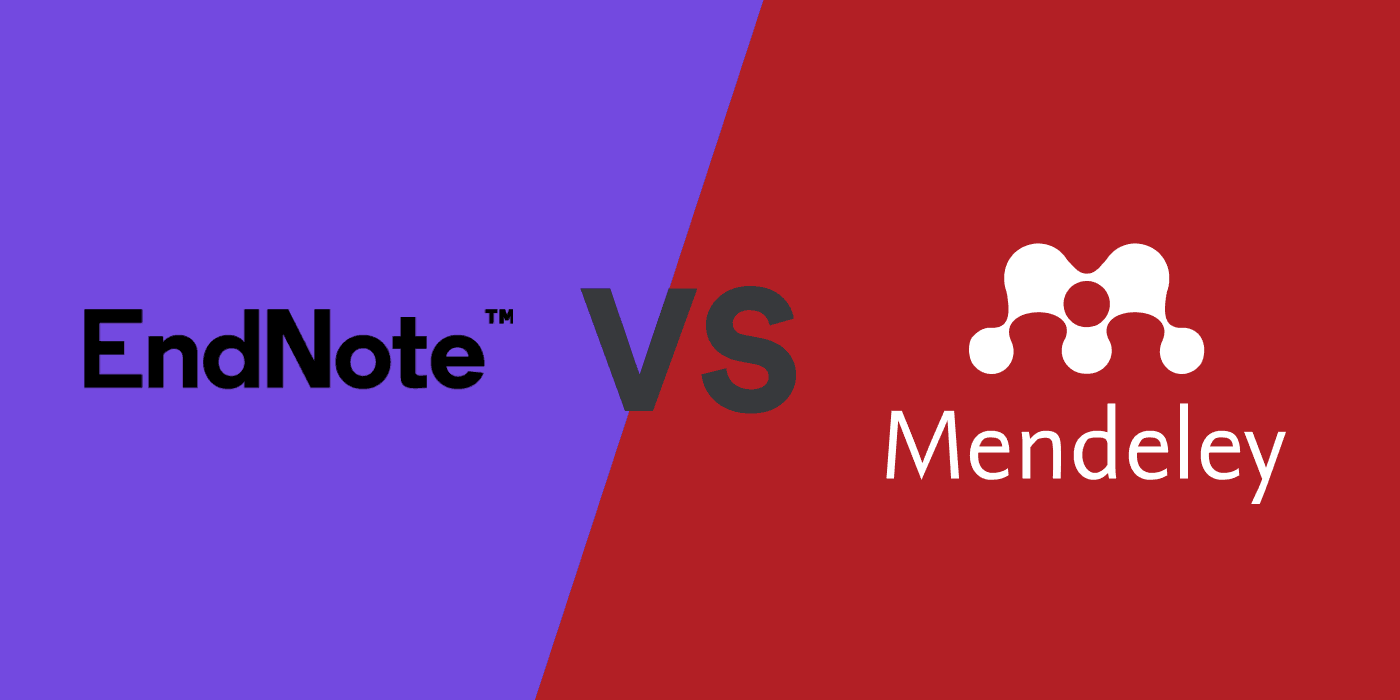
Every researcher requires support in handling, organizing, and citing their references. This is where reference management software comes into play.
However, with so many choices out there, selecting the ideal tool can be challenging. To make this choice easier, we'll explore two reference management tools that could suit your research needs: EndNote and Mendeley.
EndNote vs Mendeley: Detailed feature comparison table
Here's a side-by-side comparison of the main features of both tools. Continue reading for an in-depth analysis of the differences between the two applications.
| EndNote | Mendeley | |
|---|---|---|
| Platform Compatibility | 4/7 | 4/7 |
| Web | ||
| iOS | ||
| Android | ||
| Windows | ||
| MacOS | ||
| Linux | ||
| ChromeOS | ||
| Web clipper | 4/5 | 5/5 |
| Chrome | ||
| Edge | ||
| Safari | ||
| Firefox | ||
| Organize references Add references to folders within extension popup | ||
| Writing Platforms | 3/4 | 3/4 |
| Word on Windows | ||
| Word on Mac | ||
| Google Docs | ||
| Overleaf Live BibTeX integration with Overleaf | ||
| Data Import | 4.5/6 | 3.5/6 |
| Manual import with auto-completion Start typing in a title, URL, or DOI and the reference data will be filled automatically | Autocompletion only if DOI, arXiv ID or PubMed ID entered | |
| Bulk data import Users can upload RIS, BibTeX, NBIB, and PDF files. | NBIB files can’t be imported | |
| In-app literature search | ||
| Bulk import from web databases | ||
| Metadata extract from PDFs | ||
| Create references from identifiers Generate references from DOI, PMC ID, arXiv ID, PubMed ID or ISBN | DOI only | No PMC IDs or ISBNs |
| Data Export and Backup | 3/6 | 2/6 |
| BibTeX Export BibTeX files | ||
| RIS Export RIS files | ||
| Google Drive | ||
| Github | ||
| OneDrive | ||
| Full data export Export all bibliographic data, labels, folders, and PDF files with annotations | ||
| Sharing and Collaboration | 2/4 | 2/4 |
| Shared folders Integrated sharing that does not require set up of external folders in other cloud storage apps or databases | ||
| Unlimited collaborators No limit on the number of users who can access a shared folder | ||
| Collaborators can add, edit, and remove references | ||
| Share references with sharing link | ||
| PDF management | 4/6 | 2/6 |
| Custom PDF file naming | ||
| Sticky notes | ||
| Highlight annotation | ||
| Freehand drawing | ||
| Custom highlight colors | ||
| Free text annotations Write anywhere directly on pdf | ||
| Library management | 8/10 | 7.5/10 |
| Labels Also called tags | ||
| Folders | ||
| Subfolders | ||
| Starred items Also called favorites. Automatic filtering of important references displayed in UI | ||
| Notes | ||
| Duplicate detection Easily spot duplicates in your library | ||
| Detect incomplete references Automatic filtering of incomplete references | ||
| Auto-update reference metadata Get reference data updates automatically | Can look up metadata by identifier | |
| Find full text PDFs | ||
| Bulk editing of references | ||
| Library search | 5/6 | 1/6 |
| Full-text PDF Search Include full text in search | ||
| Exact phrase search Over library (fields and full-text pdfs) | ||
| Author search Search author field | ||
| Notes search Include notes in search | ||
| PDF annotations search Include PDF annotations in your search | ||
| Highlight search terms in search results | ||
| Citing | 3/4 | 1.5/4 |
| Copy citation to clipboard | Only 10 citation styles | |
| Choose citation style (Word, Google Docs) | Word only | |
| Cite from library (Word, Google Docs) | Word only | |
| Cite from online search | ||
| LaTeX Support | 0/3 | 1/3 |
| Copy BibTeX to clipboard | ||
| Create custom BibTeX key pattern | ||
| BibLaTeX support Export .bib file with BibLaTeX fields | ||
| Support and Community | 2/3 | 1/3 |
| Community forum | ||
| Customer support via in app chat | ||
| Customer support by email | ||
| Pricing | ||
| Free version (e.g., short-one time project) | 30 day free trial EndNote Online can be used for free | Up to 2GB cloud storage for PDFs free |
| Academic user subscription price | $275 for 3 years unlimited cloud storage | $165/year for unlimited cloud storage |
What is EndNote?
EndNote is reference management software developed by Clarivate Analytics that allows researchers to organize citations and create bibliographies for scholarly work.
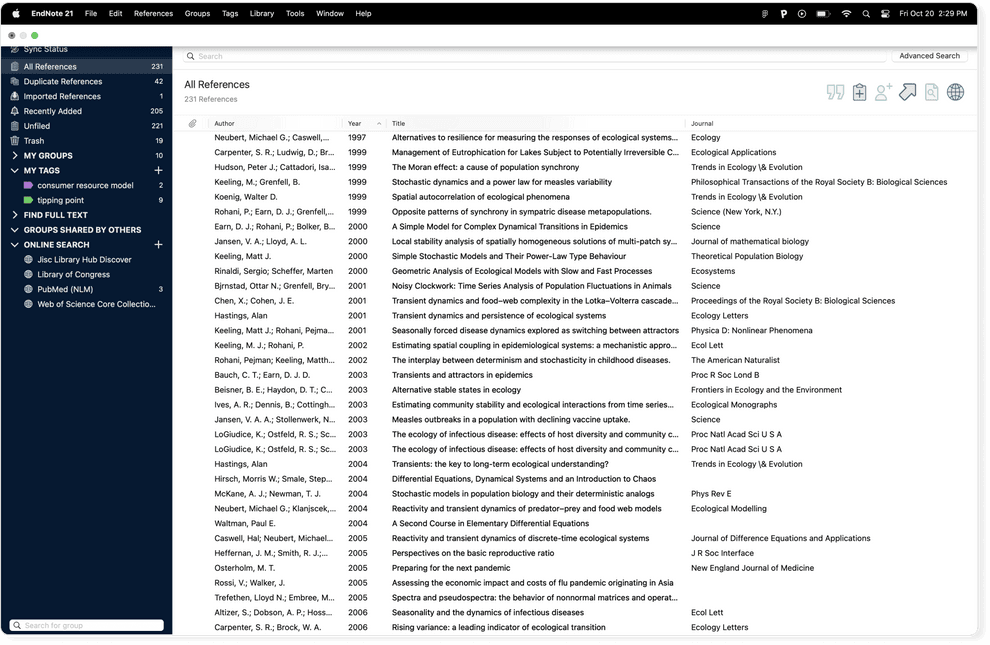
What is Mendeley?
Mendeley Reference Manager is a tool that helps researchers in organizing their papers, annotating PDFs, and creating citations. Originally an independent product, it was acquired by Elsevier. Mendeley offers both free and premium versions.
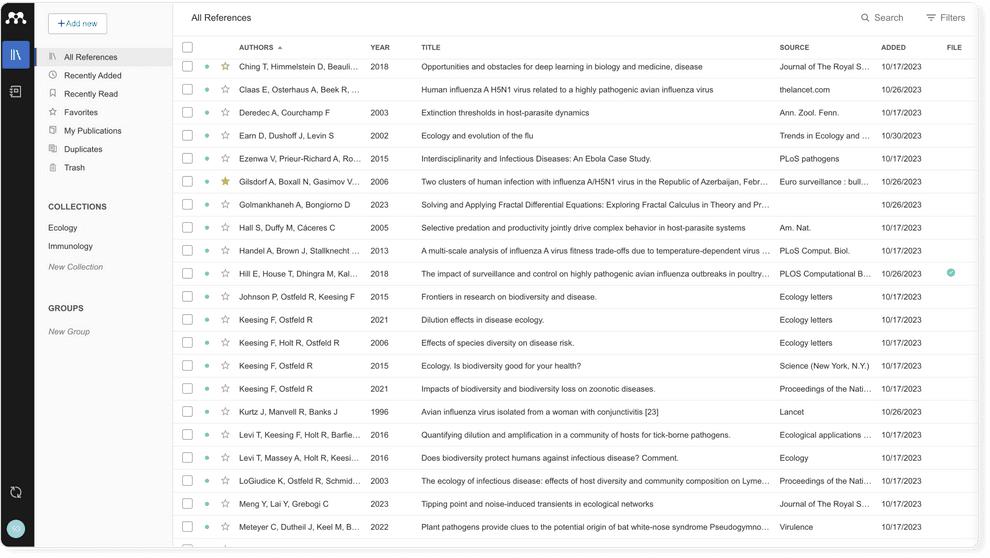
EndNote vs Mendeley: 4 factors to consider
When deciding between EndNote and Mendeley, your choice will hinge on a few crucial points:
Price. A full license for EndNote 21 is priced at $275, and you'll need to buy a new license for significant future updates. However, your academic institution might offer it at no cost. On the other hand, you can sign up to use Mendeley for free. The free plan includes up to 2GB of library storage. If you require more space, you need to upgrade to a premium account—fees begin at $55 annually for up to 5GB and can reach $165 annually for unlimited storage.
Storage requirements. EndNote has unlimited storage for its price, whereas you have to upgrade your Mendeley account to increase your storage for PDFs.
Cross-platform availability. Mendeley can be installed on Windows, MacOS and Linux machines, but it does not have any mobile apps. EndNote can be installed on Windows and MacOS computers, and it has an iOS app.
Customization and flexibility needs. EndNote is known for its high degree of customization in terms of reference information, citation styles, and library organization. In contrast, Mendeley offers limited customization functions, but it’s user-friendly for early career researchers. Senior researchers might find EndNote more flexible for specific needs.
EndNote vs Mendeley: Endnote has advanced search functionality whereas Mendeley does not
EndNote has three primary search features:
- Quick Search: Located at the top of the EndNote interface, the Quick Search bar allows users to type in keywords, author names, titles, etc., and quickly retrieve matching references from their library. To search for a phrase, put it in quotation marks.
- Advanced Search: For more refined searches, users can use the "Advanced Search" option. This feature allows users to set multiple search parameters, combine search terms using Boolean operators (AND, OR, NOT), and specify fields (like author, year, journal, etc.) to search within.
- Online Search: EndNote allows users to search online databases (like PubMed, Web of Science, and many others) directly from within the software.
In contrast to EndNote, Mendeley does not have any advanced search features. Its search is simple: a search box with no dropdown menus or options.
You can search over title, authors, year, and source type. Such limited options may be okay if you’ve a small library, but as your library grows, you may need to do more specific searches.
While you can specify your search over a collection, and you can filter by author names and tags, a major limitation of Mendeley Reference Manager is that it does not have full-text search (which was offered in the now discontinued Mendeley Desktop).
EndNote vs Mendeley: Mendeley has a cleaner UI than EndNote
Mendeley’s user interface is minimalist and easy to navigate for a beginner. The left panel includes “Recently Added”, “Recently Read”, and “Favorites” for quick access to references you are working with, the search bar and filter options are located on the top left above the library.
All of Mendeley’s features can be accessed in a few clicks — there are no complicated menus to navigate. For example, by selecting references, you can organize, export, or mark them as favorites.

In contrast, EndNote has a more traditional, feature-rich interface. The number of options and menus can be intimidating to new users. For example, unlike Mendeley, you can’t mark important references as favorites (although you can add ratings) and the context menu has a myriad of options for references:
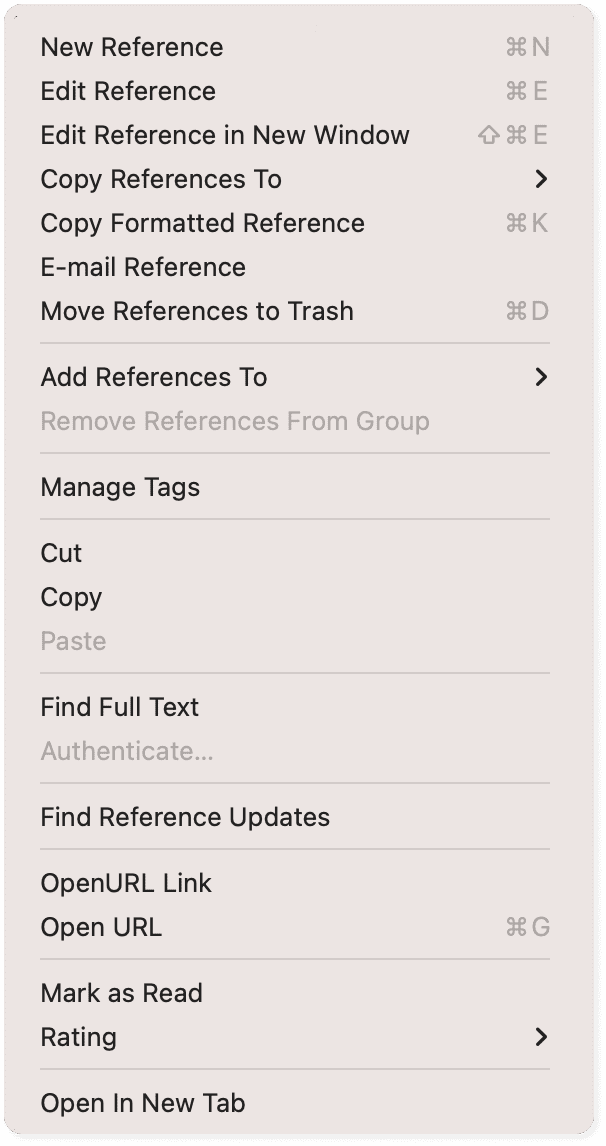
But the upside of this is EndNote offers more advanced reference management options, if you’re happy to spend time learning to use it.
EndNote vs Mendeley: EndNote is more feature-rich than Mendeley
Mendeley Reference Manager provides a straightforward reference management experience with essential functions, but it lacks many advanced features:
- Mendeley has only three options for reference export: BibTeX, RIS and XML. EndNote, on the other hand, has many export options via Tools > Output Style, and you can upload other output styles if needed.
- You can edit the data of multiple references simultaneously in EndNote.
- EndNote offers a large range of citation styles when you copy a reference in your library to the clipboard. In contrast, you can only copy citations in ten citation styles with Mendeley Reference Manager.
EndNote also has organization capabilities that Mendeley doesn’t have. For example, EndNote allows you to generate smart groups, where you can save searches and these will dynamically update as you add references to your library.
Unlike Mendeley Reference Manager, EndNote has a wide range of customization options, accessible via Settings (or Edit > Preferences on Windows).
- You can decide what naming structure you would like your attachments to follow by opening the PDF Handling dialog.
- You can choose words whose capitalization you would like to keep in your bibliographies (e.g., DNA) via the Change Case dialog.
- You can customize the reference types and the fields displayed for each reference by opening the Reference Types dialog.
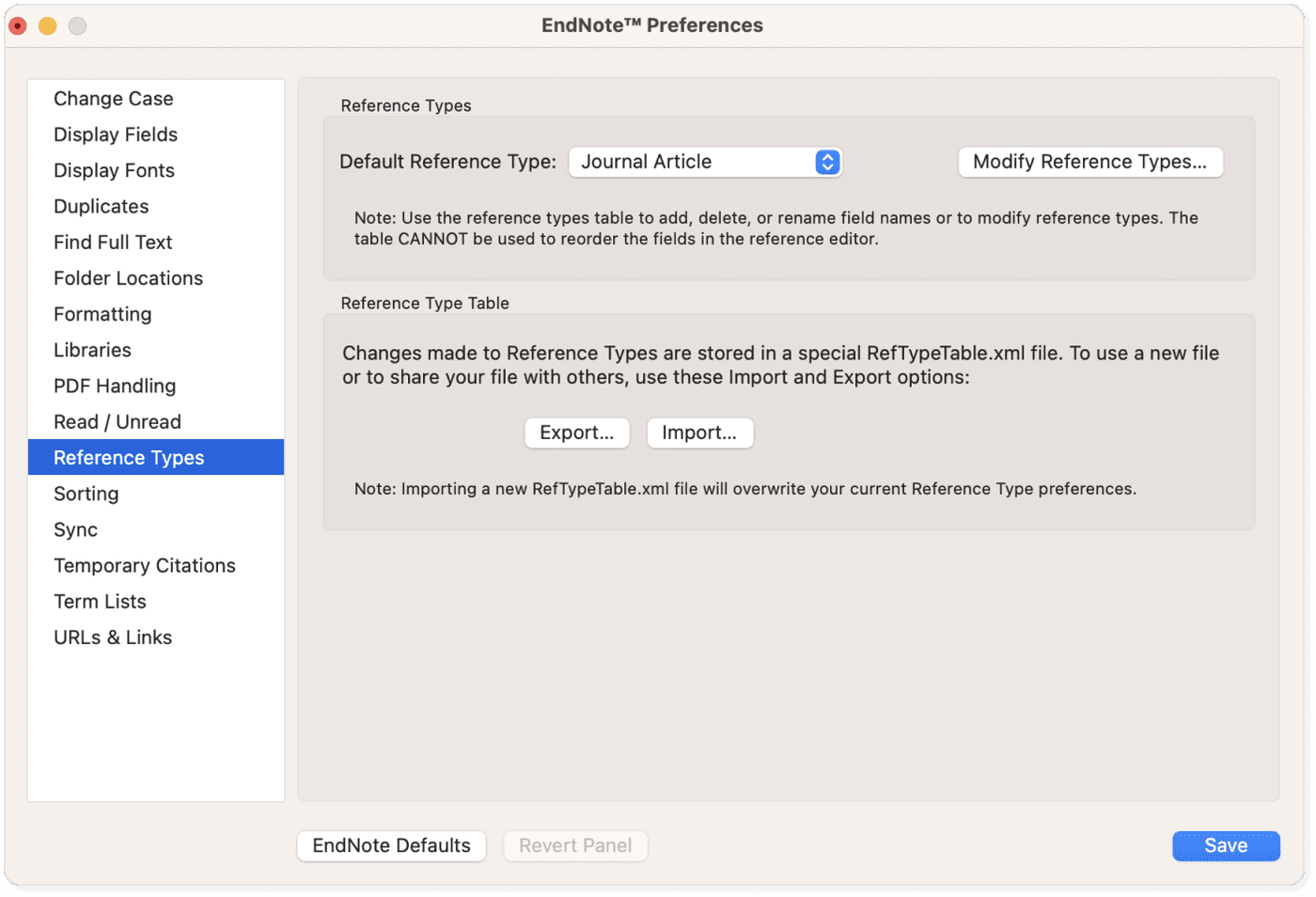
And if you do decide to migrate from EndNote, it’s easy to get your annotated PDFs as they can be found in a folder on your machine. In contrast, if you want to download your PDFs from Mendeley, you must download them individually from the PDF viewer.
EndNote vs Mendeley: Mendeley has more features for LaTeX users than EndNote
Mendeley has more LaTeX and BibTeX functionalities than EndNote.
Right-clicking on any reference in your Mendeley library gives a menu where you can copy its LaTeX citation and its BibTeX entry.
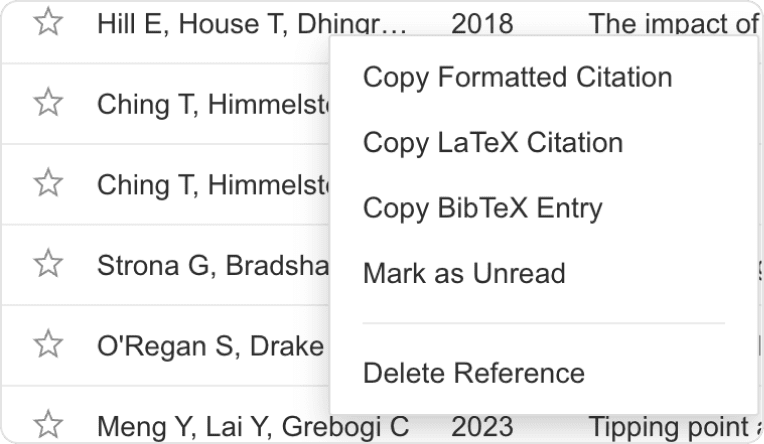
You can also add your own BibTeX citation keys to any reference in the reference information sidebar.
You can link your Mendeley account to Overleaf, a LaTeX document writing platform.
In contrast, EndNote does not have any of these features. Like Mendeley, you can import BibTeX files to EndNote by specifying the BibTeX import filter and export BibTeX files by selecting the BibTeX output style (both of these can selected via the Tools menu in EndNote), but those are the only features it offers for LaTeX users.
EndNote vs Mendeley: EndNote has better reference updating functionality than Mendeley
EndNote’s “Find Reference Updates” feature uses information from databases such as Web of Science and PubMed to populate incomplete and missing fields of journal articles in your library.
For example you can enter a title, year, and journal and it will complete the rest of the reference information for you.
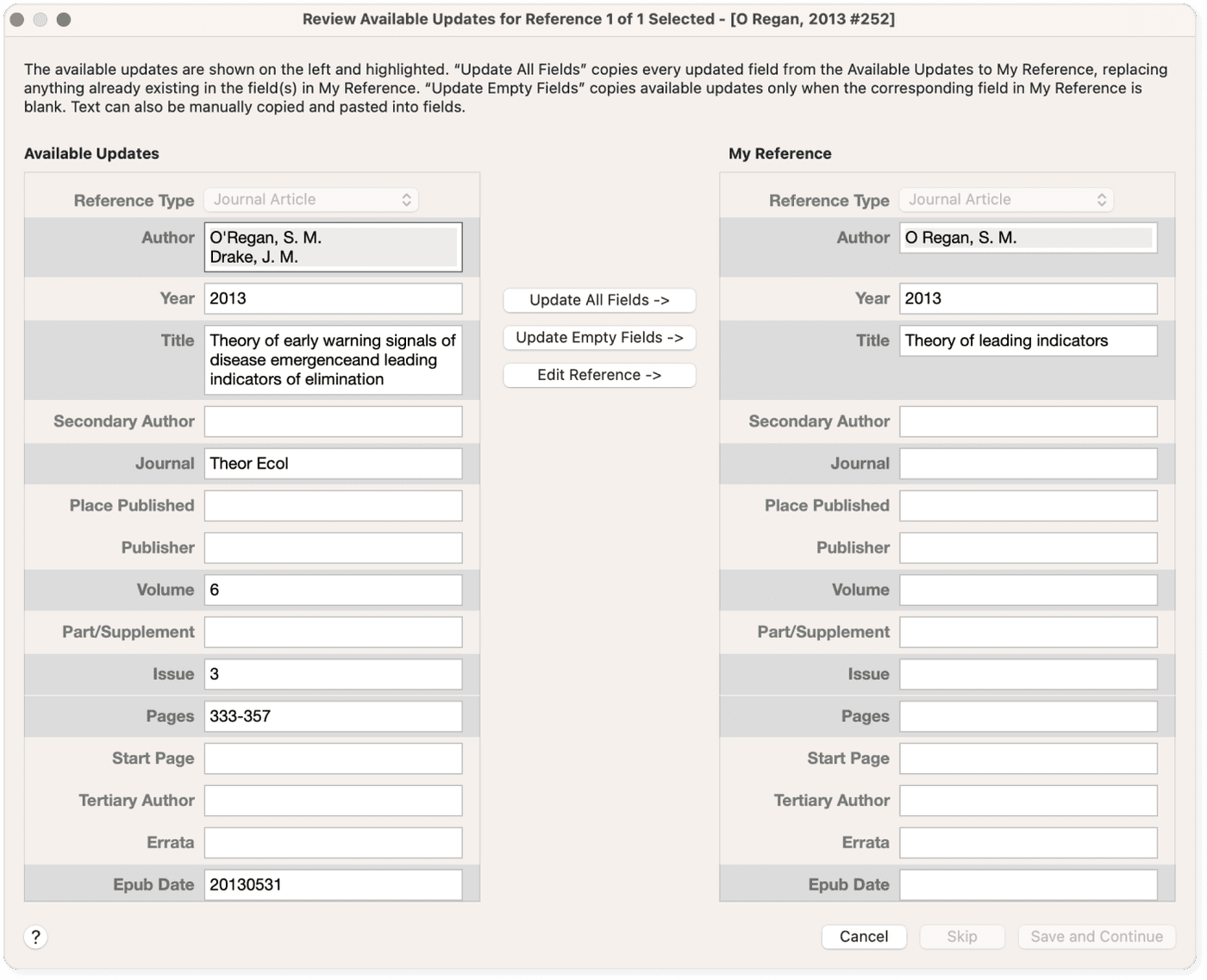
You can choose to update all the fields, or choose to only update empty fields. You can also choose to edit the reference—this will allow you to copy data from the Available Updates panel and paste it into the My Reference panel.
In contrast, Mendeley updates missing information using certain identifiers — DOIs, PubMed IDs, and arXiv IDs. You need to have one of these identifiers to use the feature.
Once you click on the magnifying glass icon next to the identifier, all of the reference fields instantly update. You don’t get to check the changes for accuracy.

EndNote vs Mendeley: Mendeley’s web app has more features than EndNote’s
Mendeley Reference Manager is both a web and desktop app. The web app has all the same features as the desktop application.
In contrast, EndNote Web does not have the full functionality of EndNote’s desktop app. While it serves as an online backup of your library, it lacks some important features.

While it serves as an online backup of your library, it lacks some important features.
- EndNote Web does not have an inbuilt PDF viewer (you can’t view PDFs you’ve annotated in the desktop app)
- It has limited import and export capabilities (only RIS files are supported)
- It lacks the advanced search features found in the desktop app (you can’t search full text of PDFs or search databases, for example)
- There is no context menu upon right-clicking a reference.
If you prefer to use your reference manager in the browser rather a desktop app, Mendeley Reference Manager is the better choice in this situation.
EndNote vs Mendeley: Which is better?
Both tools are useful in different research contexts. Which is better depends on your needs and preferences for citation management.
EndNote is the better option if:
- You have an extensive library and regularly use advanced search features to find bibliographic items
- You require unlimited storage for PDFs and attachments
- You need a range of reference management features and customization options.
Mendeley Reference Manager is the better option if:
- You prefer to use a streamlined reference manager with all of the basic reference management features
- You want to use the free plan because your library is small and you don’t have extensive reference management needs
- You write your documents with LaTeX.
To make the best decision for you, you will need to give both a go.
Related reading
⇨ How to import references from Mendeley to Paperpile